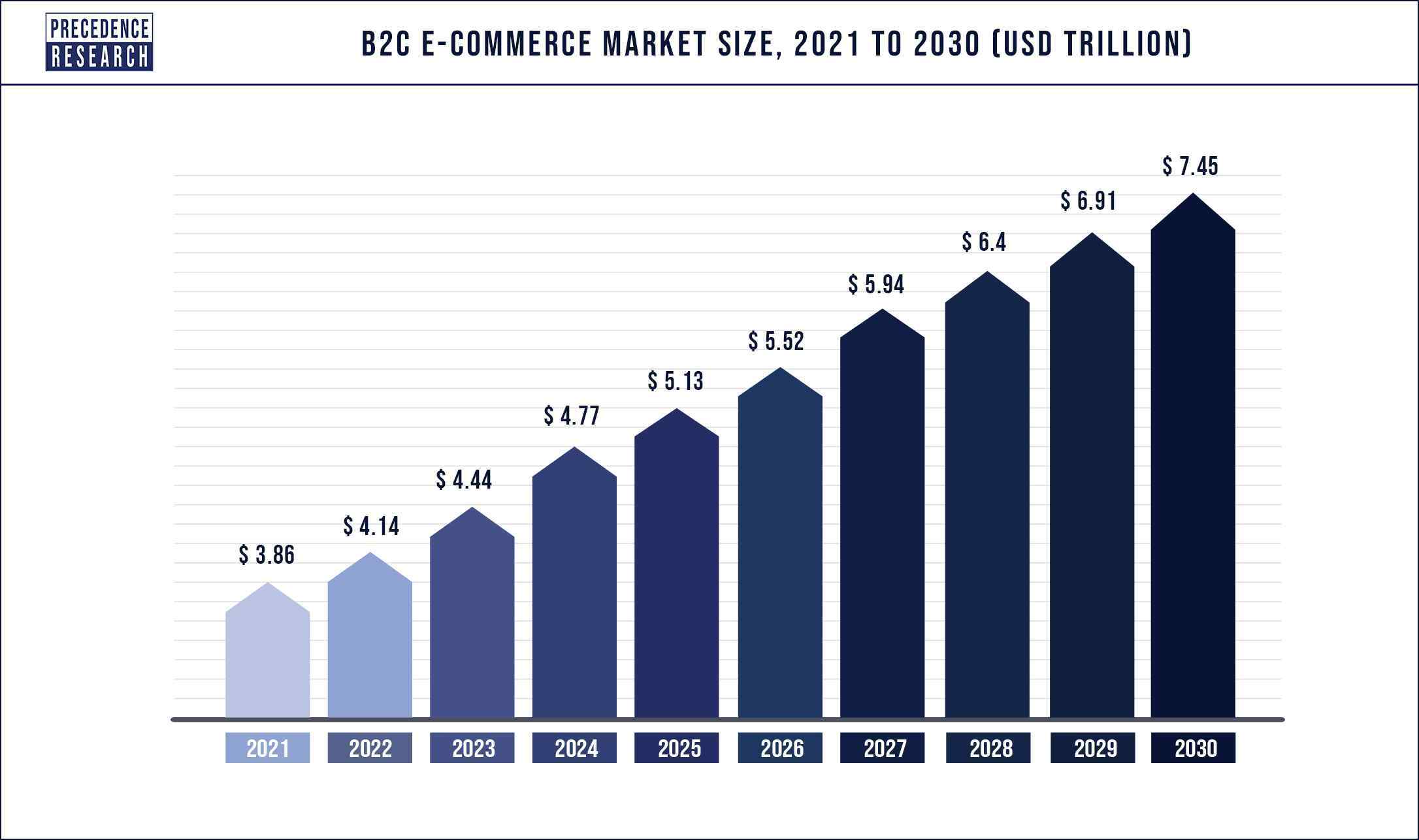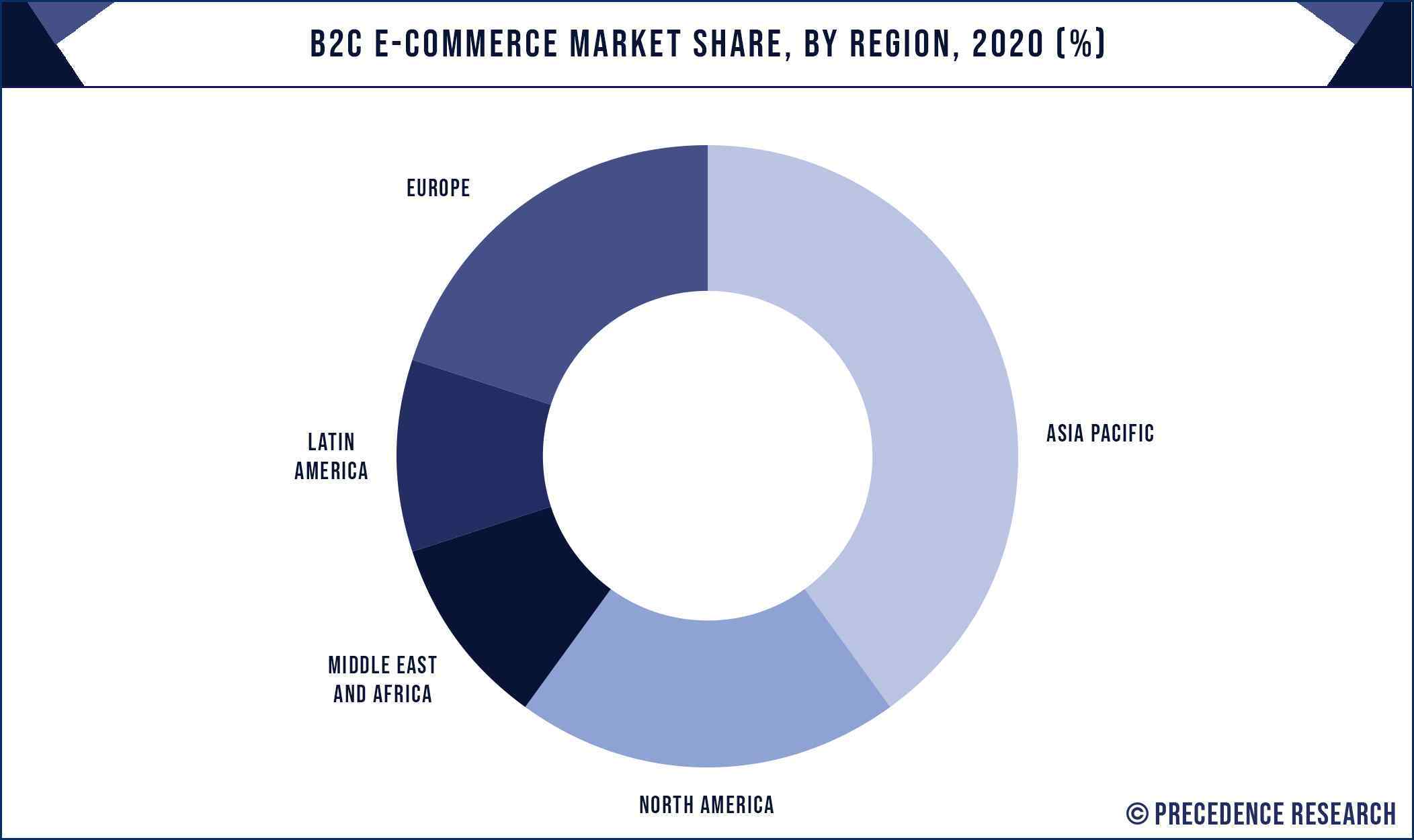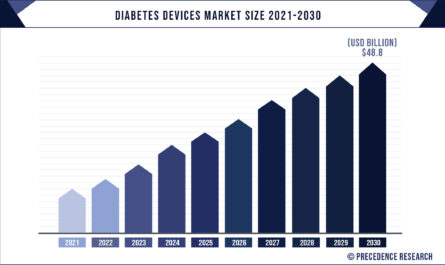The globla B2C e-commerce market size exceeded 3.86 trillion in 2021, grew to US$ 4.14 trillion USD in 2022, and is projected to reach US$ 7.45 trillion by 2030, growing at a CAGR of 7.6% every year, according to a 2021 study by Precedence Research, the Canada-based market Insight Company.

The proliferation of digital technologies, globalization of businesses, ease of doing business, favorable government policies, improved logistics infrastructure, and improved telecommunications and IT infrastructure are several prominent factors that has boosted the growth of the global b2c e-commerce market. The rising disposable income, increasing adoption of smartphones, increased demand for the convenient shopping, availability of almost all products of all brands on the e-commerce platforms, and growing penetration of the different e-commerce platforms across the globe is augmenting the market growth.
The aggressive marketing strategies adopted by the payers and increased investments in the social media marketing and digital marketing in the recent years has significantly driven the growth of the global b2c e-commerce market. Moreover, the easy and convenient payment options, 24/7 customer support, door step home delivery to almost every locations, and convenient refund and replacement policies of the e-commerce platforms has augmented the demand for the b2c e-commerce channels among the global customers.
The base year for the study has been considered 2021, the historic year 2017 and 2020, the forecast period considered is from 2022 to 2030. The B2C e-commerce market is analyzed on the basis of value (US$ Million), volume (Unit), and price (US$/Unit).
| Report Scope | Details |
| Market Size | USD 7.45 trillion by 2030 |
| Growth Rate | CAGR of 7.6% from 2022 to 2030 |
| Asia Pacific Market Share | 37% in 2020 |
| Clothing & Footwear Revenue Share | 25% in 2020 |
| b2c Retailers Revenue Share | 99% in 2020 |
B2C E-Commerce Market Report Highlights
- Based on the type, the b2c retailer segment dominated the market, garnering a market share of over 99% in 2020. This is attributed to the increased adoption of the online/e-commerce platforms for shopping among the urban consumers. The rising penetration of internet and smartphones along with the presence of all the products on the e-commerce platforms has attracted a huge customer bases.
- Based on the application, the consumer electronics is estimated to be the most opportunistic market. The integration of latest technologies like AI, IoT, and wireless connectivity in the various consumer electronics is fueling the demand for the electronic products. The increased preferences for buying the consumer electronic through the e-commerce channels are propelling the growth of this segment.
B2C E-Commerce Market Regional Snapshot
Asia Pacific dominated the global b2c e-commerce market, garnering a market share of around 37% in 2020. Asia Pacific has a huge customer base owing to the presence of almost 60% of the global population. Moreover, the increased adoption of smartphones and improved access to the internet are the most important growth drivers. The busy and hectic life schedules of the customers has resulted in the increased demand for the convenient shopping.
The b2c e-commerce platforms offers wide variety of products and different brands and the shoppers can easily shop from the convenience of their homes. The rising urban population, rising investments in the development of infrastructure, and growing awareness regarding the benefits of e-commerce is accelerating the growth of the b2c e-commerce market in Asia Pacific. Moreover, the rising popularity of the second hand online market place like OLX and Quikr in the developing countries is boosting the e-commerce market growth.
North America was the second leading market in 2020. North America is characterized by the presence of several top e-commerce platforms and the increased adoption rate of the digital technologies. The higher penetration of the e-commerce and the presence of strong, developed, and fast logistics infrastructure has facilitated the market growth in North America.
B2C E-Commerce Market Dynamics
Driver
Rapidly growing number of internet users
The proliferation of the digital technologies has boosted the adoption of smartphones and access to the internet across the globe. Most of the internet users access through their smartphones. Therefore, the combination of the smartphone and access to the internet has significantly boosted the growth of the b2c e-commerce market.According to the International Telecommunication Union, there were around 4.9 billion (63% of the global population) internet users by the end of 2021. This number was 4.1 billion in 2019 and it grew rapidly by 782 million in 2 years.
Restraint
Lack of knowledge in the rural areas
The illiteracy rate is significantly high in the rural areas of the developing and the underdeveloped countries. The population lacks the knowledge about the operating the smartphones and internet. Furthermore, the majority of the population lives in the rural areas. This is a major restraining factor that may hinder the market growth.
Read Also: Healthcare Reimbursement Market Size to Touch US$ 17.63 Trillion By 2030
Opportunity
Rising investments in the development of infrastructure
The governments in the underdeveloped and the developing nations are heavily investing in improving the connectivity by building networks of road, airways, and railways that can efficiently boost the growth of the logistics. The improved logistics will boost the delivery activities of the e-commerce platforms.
Some of the prominent players in the global B2C e-commerce market include:
- Alibaba Group Holding Limited
- Amazon.com Inc.
- ASOS plc
- Booking Holdings Inc.
- eBay Inc.
- JD.com Inc.
- Macy’s Inc.
- Makemytrip Limited
- Otto GmbH & Co KG
- Rakuten Inc.
- Walmart Inc.
Segments Covered in the Report
By Type
- Classifieds
- B2C Retailers
By Application
- Consumer Electronics
- Automotive
- Books & Stationery
- Clothing & Footwear
- Beauty & Personal Care
- Media & Entertainment
- Home Décor & Electronics
- Travel & Tourism
- Sports & Leisure
- Information & Technology
- Others
By Brand Type
- Single Brand
- Multi Brand
By Device
- PCs
- Smart Phone
- Tablet
- Others
By Geography
- North America
- U.S.
- Canada
- Europe
- U.K.
- Germany
- France
- Asia-Pacific
- China
- India
- Japan
- South Korea
- Malaysia
- Philippines
- Latin America
- Brazil
- Rest of Latin America
- Middle East & Africa (MEA)
- GCC
- North Africa
- South Africa
- Rest of the Middle East & Africa
Thanks for reading you can also get individual chapter-wise sections or region-wise report versions such as North America, Europe, or the Asia Pacific.
TABLE OF CONTENT
Chapter 1. Introduction
1.1. Research Objective
1.2. Scope of the Study
1.3. Definition
Chapter 2. Research Methodology
2.1. Research Approach
2.2. Data Sources
2.3. Assumptions & Limitations
Chapter 3. Executive Summary
3.1. Market Snapshot
Chapter 4. Market Variables and Scope
4.1. Introduction
4.2. Market Classification and Scope
4.3. Industry Value Chain Analysis
4.3.1. Raw Material Procurement Analysis
4.3.2. Sales and Distribution Channel Analysis
4.3.3. Downstream Buyer Analysis
Chapter 5. COVID 19 Impact on B2C E-Commerce Market
5.1. COVID-19 Landscape: B2C E-Commerce Industry Impact
5.2. COVID 19 – Impact Assessment for the Industry
5.3. COVID 19 Impact: Global Major Government Policy
5.4. Market Trends and Opportunities in the COVID-19 Landscape
Chapter 6. Market Dynamics Analysis and Trends
6.1. Market Dynamics
6.1.1. Market Drivers
6.1.2. Market Restraints
6.1.3. Market Opportunities
6.2. Porter’s Five Forces Analysis
6.2.1. Bargaining power of suppliers
6.2.2. Bargaining power of buyers
6.2.3. Threat of substitute
6.2.4. Threat of new entrants
6.2.5. Degree of competition
Chapter 7. Competitive Landscape
7.1.1. Company Market Share/Positioning Analysis
7.1.2. Key Strategies Adopted by Players
7.1.3. Vendor Landscape
7.1.3.1. List of Suppliers
7.1.3.2. List of Buyers
Chapter 8. Global B2C E-Commerce Market, By Type
8.1. B2C E-Commerce Market, by Type, 2022-2030
8.1.1. Classifieds
8.1.1.1. Market Revenue and Forecast (2017-2030)
8.1.2. B2C Retailers
8.1.2.1. Market Revenue and Forecast (2017-2030)
Chapter 9. Global B2C E-Commerce Market, By Application
9.1. B2C E-Commerce Market, by Application, 2022-2030
9.1.1. Consumer Electronics
9.1.1.1. Market Revenue and Forecast (2017-2030)
9.1.2. Automotive
9.1.2.1. Market Revenue and Forecast (2017-2030)
9.1.3. Books & Stationery
9.1.3.1. Market Revenue and Forecast (2017-2030)
9.1.4. Clothing & Footwear
9.1.4.1. Market Revenue and Forecast (2017-2030)
9.1.5. Beauty & Personal Care
9.1.5.1. Market Revenue and Forecast (2017-2030)
9.1.6. Media & Entertainment
9.1.6.1. Market Revenue and Forecast (2017-2030)
9.1.7. Home Décor & Electronics
9.1.7.1. Market Revenue and Forecast (2017-2030)
9.1.8. Travel & Tourism
9.1.8.1. Market Revenue and Forecast (2017-2030)
9.1.9. Sports & Leisure
9.1.9.1. Market Revenue and Forecast (2017-2030)
9.1.10. Information & Technology
9.1.10.1. Market Revenue and Forecast (2017-2030)
9.1.11. Others
9.1.11.1. Market Revenue and Forecast (2017-2030)
Chapter 10. Global B2C E-Commerce Market, By Brand Type
10.1. B2C E-Commerce Market, by Brand Type, 2022-2030
10.1.1. Single Brand
10.1.1.1. Market Revenue and Forecast (2017-2030)
10.1.2. Multi Brand
10.1.2.1. Market Revenue and Forecast (2017-2030)
Chapter 11. Global B2C E-Commerce Market, By Device Type
11.1. B2C E-Commerce Market, by Device Type, 2022-2030
11.1.1. PCs
11.1.1.1. Market Revenue and Forecast (2017-2030)
11.1.2. Smart Phone
11.1.2.1. Market Revenue and Forecast (2017-2030)
11.1.3. Tablet
11.1.3.1. Market Revenue and Forecast (2017-2030)
11.1.4. Others
11.1.4.1. Market Revenue and Forecast (2017-2030)
Chapter 12. Global B2C E-Commerce Market, Regional Estimates and Trend Forecast
12.1. North America
12.1.1. Market Revenue and Forecast, by Type (2017-2030)
12.1.2. Market Revenue and Forecast, by Application (2017-2030)
12.1.3. Market Revenue and Forecast, by Brand Type (2017-2030)
12.1.4. Market Revenue and Forecast, by Device Type (2017-2030)
12.1.5. U.S.
12.1.5.1. Market Revenue and Forecast, by Type (2017-2030)
12.1.5.2. Market Revenue and Forecast, by Application (2017-2030)
12.1.5.3. Market Revenue and Forecast, by Brand Type (2017-2030)
12.1.5.4. Market Revenue and Forecast, by Device Type (2017-2030)
12.1.6. Rest of North America
12.1.6.1. Market Revenue and Forecast, by Type (2017-2030)
12.1.6.2. Market Revenue and Forecast, by Application (2017-2030)
12.1.6.3. Market Revenue and Forecast, by Brand Type (2017-2030)
12.1.6.4. Market Revenue and Forecast, by Device Type (2017-2030)
12.2. Europe
12.2.1. Market Revenue and Forecast, by Type (2017-2030)
12.2.2. Market Revenue and Forecast, by Application (2017-2030)
12.2.3. Market Revenue and Forecast, by Brand Type (2017-2030)
12.2.4. Market Revenue and Forecast, by Device Type (2017-2030)
12.2.5. UK
12.2.5.1. Market Revenue and Forecast, by Type (2017-2030)
12.2.5.2. Market Revenue and Forecast, by Application (2017-2030)
12.2.5.3. Market Revenue and Forecast, by Brand Type (2017-2030)
12.2.5.4. Market Revenue and Forecast, by Device Type (2017-2030)
12.2.6. Germany
12.2.6.1. Market Revenue and Forecast, by Type (2017-2030)
12.2.6.2. Market Revenue and Forecast, by Application (2017-2030)
12.2.6.3. Market Revenue and Forecast, by Brand Type (2017-2030)
12.2.6.4. Market Revenue and Forecast, by Device Type (2017-2030)
12.2.7. France
12.2.7.1. Market Revenue and Forecast, by Type (2017-2030)
12.2.7.2. Market Revenue and Forecast, by Application (2017-2030)
12.2.7.3. Market Revenue and Forecast, by Brand Type (2017-2030)
12.2.7.4. Market Revenue and Forecast, by Device Type (2017-2030)
12.2.8. Rest of Europe
12.2.8.1. Market Revenue and Forecast, by Type (2017-2030)
12.2.8.2. Market Revenue and Forecast, by Application (2017-2030)
12.2.8.3. Market Revenue and Forecast, by Brand Type (2017-2030)
12.2.8.4. Market Revenue and Forecast, by Device Type (2017-2030)
12.3. APAC
12.3.1. Market Revenue and Forecast, by Type (2017-2030)
12.3.2. Market Revenue and Forecast, by Application (2017-2030)
12.3.3. Market Revenue and Forecast, by Brand Type (2017-2030)
12.3.4. Market Revenue and Forecast, by Device Type (2017-2030)
12.3.5. India
12.3.5.1. Market Revenue and Forecast, by Type (2017-2030)
12.3.5.2. Market Revenue and Forecast, by Application (2017-2030)
12.3.5.3. Market Revenue and Forecast, by Brand Type (2017-2030)
12.3.5.4. Market Revenue and Forecast, by Device Type (2017-2030)
12.3.6. China
12.3.6.1. Market Revenue and Forecast, by Type (2017-2030)
12.3.6.2. Market Revenue and Forecast, by Application (2017-2030)
12.3.6.3. Market Revenue and Forecast, by Brand Type (2017-2030)
12.3.6.4. Market Revenue and Forecast, by Device Type (2017-2030)
12.3.7. Japan
12.3.7.1. Market Revenue and Forecast, by Type (2017-2030)
12.3.7.2. Market Revenue and Forecast, by Application (2017-2030)
12.3.7.3. Market Revenue and Forecast, by Brand Type (2017-2030)
12.3.7.4. Market Revenue and Forecast, by Device Type (2017-2030)
12.3.8. Rest of APAC
12.3.8.1. Market Revenue and Forecast, by Type (2017-2030)
12.3.8.2. Market Revenue and Forecast, by Application (2017-2030)
12.3.8.3. Market Revenue and Forecast, by Brand Type (2017-2030)
12.3.8.4. Market Revenue and Forecast, by Device Type (2017-2030)
12.4. MEA
12.4.1. Market Revenue and Forecast, by Type (2017-2030)
12.4.2. Market Revenue and Forecast, by Application (2017-2030)
12.4.3. Market Revenue and Forecast, by Brand Type (2017-2030)
12.4.4. Market Revenue and Forecast, by Device Type (2017-2030)
12.4.5. GCC
12.4.5.1. Market Revenue and Forecast, by Type (2017-2030)
12.4.5.2. Market Revenue and Forecast, by Application (2017-2030)
12.4.5.3. Market Revenue and Forecast, by Brand Type (2017-2030)
12.4.5.4. Market Revenue and Forecast, by Device Type (2017-2030)
12.4.6. North Africa
12.4.6.1. Market Revenue and Forecast, by Type (2017-2030)
12.4.6.2. Market Revenue and Forecast, by Application (2017-2030)
12.4.6.3. Market Revenue and Forecast, by Brand Type (2017-2030)
12.4.6.4. Market Revenue and Forecast, by Device Type (2017-2030)
12.4.7. South Africa
12.4.7.1. Market Revenue and Forecast, by Type (2017-2030)
12.4.7.2. Market Revenue and Forecast, by Application (2017-2030)
12.4.7.3. Market Revenue and Forecast, by Brand Type (2017-2030)
12.4.7.4. Market Revenue and Forecast, by Device Type (2017-2030)
12.4.8. Rest of MEA
12.4.8.1. Market Revenue and Forecast, by Type (2017-2030)
12.4.8.2. Market Revenue and Forecast, by Application (2017-2030)
12.4.8.3. Market Revenue and Forecast, by Brand Type (2017-2030)
12.4.8.4. Market Revenue and Forecast, by Device Type (2017-2030)
12.5. Latin America
12.5.1. Market Revenue and Forecast, by Type (2017-2030)
12.5.2. Market Revenue and Forecast, by Application (2017-2030)
12.5.3. Market Revenue and Forecast, by Brand Type (2017-2030)
12.5.4. Market Revenue and Forecast, by Device Type (2017-2030)
12.5.5. Brazil
12.5.5.1. Market Revenue and Forecast, by Type (2017-2030)
12.5.5.2. Market Revenue and Forecast, by Application (2017-2030)
12.5.5.3. Market Revenue and Forecast, by Brand Type (2017-2030)
12.5.5.4. Market Revenue and Forecast, by Device Type (2017-2030)
12.5.6. Rest of LATAM
12.5.6.1. Market Revenue and Forecast, by Type (2017-2030)
12.5.6.2. Market Revenue and Forecast, by Application (2017-2030)
12.5.6.3. Market Revenue and Forecast, by Brand Type (2017-2030)
12.5.6.4. Market Revenue and Forecast, by Device Type (2017-2030)
Chapter 13. Company Profiles
13.1. Alibaba Group Holding Limited
13.1.1. Company Overview
13.1.2. Product Offerings
13.1.3. Financial Performance
13.1.4. Recent Initiatives
13.2. Amazon.com Inc.
13.2.1. Company Overview
13.2.2. Product Offerings
13.2.3. Financial Performance
13.2.4. Recent Initiatives
13.3. ASOS plc
13.3.1. Company Overview
13.3.2. Product Offerings
13.3.3. Financial Performance
13.3.4. Recent Initiatives
13.4. Booking Holdings Inc.
13.4.1. Company Overview
13.4.2. Product Offerings
13.4.3. Financial Performance
13.4.4. Recent Initiatives
13.5. eBay Inc.
13.5.1. Company Overview
13.5.2. Product Offerings
13.5.3. Financial Performance
13.5.4. Recent Initiatives
13.6. JD.com Inc.
13.6.1. Company Overview
13.6.2. Product Offerings
13.6.3. Financial Performance
13.6.4. Recent Initiatives
13.7. Macy’s Inc.
13.7.1. Company Overview
13.7.2. Product Offerings
13.7.3. Financial Performance
13.7.4. Recent Initiatives
13.8. Makemytrip Limited
13.8.1. Company Overview
13.8.2. Product Offerings
13.8.3. Financial Performance
13.8.4. Recent Initiatives
13.9. Otto GmbH & Co KG
13.9.1. Company Overview
13.9.2. Product Offerings
13.9.3. Financial Performance
13.9.4. Recent Initiatives
13.10. Rakuten Inc.
13.10.1. Company Overview
13.10.2. Product Offerings
13.10.3. Financial Performance
13.10.4. Recent Initiatives
13.11. Walmart Inc.
13.11.1. Company Overview
13.11.2. Product Offerings
13.11.3. Financial Performance
13.11.4. Recent Initiatives
Chapter 14. Research Methodology
14.1. Primary Research
14.2. Secondary Research
14.3. Assumptions
Chapter 15. Appendix
15.1. About Us
15.2. Glossary of Terms
Download a FREE Sample Copy (Including TOC, List of Tables & Figures, and Chart) @ https://www.precedenceresearch.com/sample/1590
Contact Us:
Mr. Alex
Sales Manager
Call: +1 9197 992 333
Email: sales@precedenceresearch.com
Frequently Asked Questions:
[sc_fs_multi_faq headline-0=”h6″ question-0=”What is the current size of B2C e-commerce market?” answer-0=”According to Precedence Research, the global B2C e-commerce market size was reached at US$ 3.86 trillion in 2021 and is anticipated to surpass US$ 7.45 trillion by 2030. ” image-0=”” headline-1=”h6″ question-1=”What will be the CAGR of global B2C e-commerce market?” answer-1=”The global B2C e-commerce market is expected to drive growth at a CAGR of 7.6% over the forecast period 2022 to 2030. ” image-1=”” headline-2=”h6″ question-2=”Who are the major players operating in the B2C e-commerce market?” answer-2=”The major players operating in the B2C e-commerce market are Alibaba Group Holding Limited, Amazon.com Inc., ASOS plc, Booking Holdings Inc., eBay Inc., JD.com Inc., Macy’s Inc., Makemytrip Limited, Otto GmbH & Co KG, Rakuten Inc., and Walmart Inc. ” image-2=”” headline-3=”h6″ question-3=”Which are the driving factors of the B2C e-commerce market?” answer-3=”The proliferation of digital technologies, globalization of businesses, ease of doing business, favorable government policies, improved logistics infrastructure, and improved telecommunications and IT infrastructure are several prominent factors that has boosted the growth of the global b2c e-commerce market. ” image-3=”” headline-4=”h6″ question-4=”Which region will lead the global B2C e-commerce market?” answer-4=”Asia Pacific dominated the global b2c e-commerce market in 2021 and will remains its dominance over the forecast period 2022 to 2030. ” image-4=”” count=”5″ html=”true” css_class=””]


